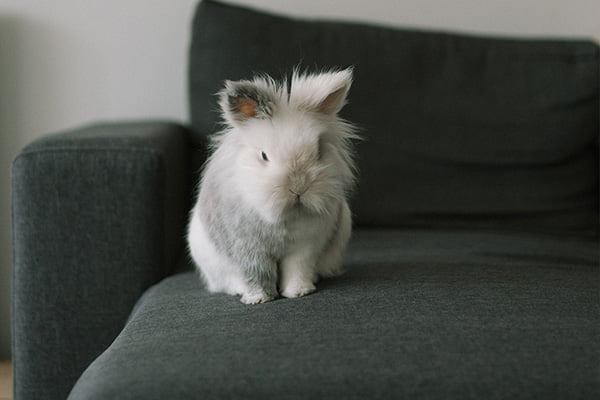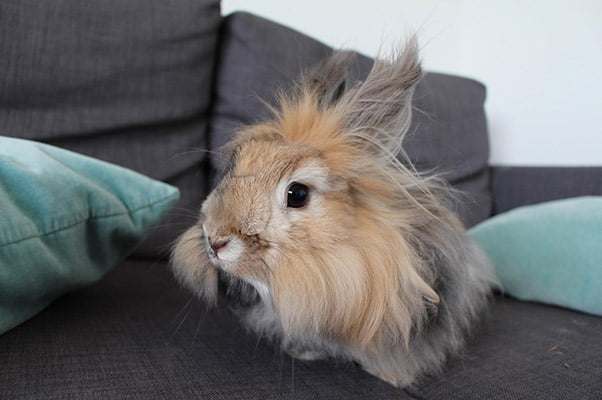Angora rabbits are fluffy and adorable cuddly pets with an old history of being beloved pets and supplying a much coveted soft fiber known as Angora wool.
Whether you are new to rabbits or getting your first angora rabbit, you may have many questions about them. Does an angora rabbit make a great pet? Are they friendly? Below, we will share everything you need to know about caring for an angora rabbit.
Name And Origin of Angora Rabbit
The Angora rabbit originated in an area formerly known as Angora, now Ankara, located in the northwestern region of present-day Turkey. Angora rabbits were brought to France in 1723, becoming a popular pet of the French royalty. By the end of the 18th century, Angora rabbits had become very popular and had spread all over Europe.
Angora rabbits are one of the oldest types of domesticated rabbits. They are categorized into eleven different distinct Angora breeds—English Angora Rabbit, French Angora Rabbit, German Angora Rabbit, Giant Angora Rabbit, Satin Angora Rabbit, Finnish Angora Rabbit, Russian Angora Rabbit, Chinese Angora Rabbit, Japanese Angora Rabbit, Korean Angora Rabbit, St. Lucian Angora Rabbit, and Swiss Angora Rabbit.
The American Rabbit Breeders Association or the International Association of German Angora Rabbit Breeders recognize five main Angora rabbit breeds. These angora rabbit breeds include English Angora, French Angora, Giant Angora, Satin Angora, and German Angora.
Angora rabbits are a popular choice among pet owners, given their unique coat, which is partially hypoallergenic, making them ideal for individuals with pet allergies. Their fur, called wool, has always been used to create a uniquely soft fiber for making clothes, but it became popular in the second World War, with Angora wool producing over 120,000 pounds. For this reason, homesteaders are interested in raising angora rabbits for wool production. They use it to generate garments to sell or to wear themselves.
Appearance and Size
Angora rabbits are renowned for having long, soft coats of thick fur. These incredibly fluffy rabbits weigh between 5 and 7 pounds as adults. Angora rabbit wool color largely depends on what breed type they are and can come in a number of markings and patterns.
Life Expectancy
Angora rabbits have a life expectancy of 7 to 10 years, though some rabbits have lived to be as old as twelve years.
Housing
Angora rabbits thrive best in environments that allow them space to run around and explore. Therefore, the Angora rabbit makes a great indoor and outdoor rabbit.
Outdoor hutches should provide protection from the elements, with one part closed and one part open so that your rabbit can hide away to feel safe when it wants. The attached runs should be safe for your rabbit. Check to ensure that all the plants and grasses are safe before letting your rabbit out. Runs should have high fenced-in walls and ideally should be covered to prevent predators from getting to your pet. Keep a close eye on your rabbit while it is outside to ensure that it is safe and comfortable in extreme climates.
Your rabbit can also be housed indoors, though it should still have space to run around at least once a day, either in a rabbit-proofed space or a fenced-in area.
Spot clean your rabbit's cage once a day or as needed, and do a full, complete cleaning at least once a week.
Angora rabbits love to chew and hide, so you should ensure your rabbit has a few hideaways, tunnels, or cardboard boxes to rest in and chew. Acceptable chew toys include natural fiber balls, wooden blocks, pine cones, apple sticks, and cardboard tubes.
Behavior & Temperament
Angora rabbits are gentle, playful, smart rabbits that love a romp around a run and some quality snuggle time. They are not usually aggressive or overly fearful, but they do not like the process of being picked up or put down and may become aggressive when frightened.

Source: Unsplash
Heat & Humidity
Angora rabbits do well outside in moderate climates. They can tolerate cold weather well but can quickly overheat in overly hot seasons with their fluffy coat. While you can choose to bring your bunny inside during the summer to avoid heatstroke, many pet owners opt for letting their bunnies adjust to the warmer temperatures and provide plenty of shade and water to keep their rabbits cool.
A few ways to keep your Angora cool in the summer is to put frozen water bottles in their hutches so they can lean against them when they get too hot. Frozen granite or ceramic tiles is another way to keep your bunny cool. Terracotta houses also provided extra cool comfort for hot bunnies. You can use a fan as well to keep air circulating. Always ensure your rabbit has a shaded area to retreat to, lots of fresh cool water, and a well-ventilated cage. At 85 degrees Fahrenheit, you will need to begin to provide some extra ways to keep your rabbit cool. At 92 or higher, your rabbit is at risk for heatstroke and could easily die. It may be wisest to bring it indoors temporarily.
Feeding
Angora rabbits should be fed a high fiber and high protein diet to ensure that their wool production is supported and to reduce the chances of wool block. High-quality commercial pellets can be found at most pet stores and should be fed twice daily in amounts of anywhere from 1/4-1/2 a cup depending on the size and age of your rabbit.
Timothy hay should be provided in unlimited quantities either free in the cage or in a hay rack. A few acceptable treats you can offer your Angora rabbit include old-fashioned oats, barley, and black oil sunflower seeds. You should strive to feed your rabbit a number of vegetables including dark leafy greens, basil, beet tops, broccoli leaves, cilantro, dandelion, endive, romaine, turnips and turnip tops, and carrot tops. Fruits can be fed in very small amounts and as a special treat. Introduce new foods slowly to ensure that your rabbit’s digestive system is not upset.
Never feed your rabbit spoiled food, nuts, sugar, onion or garlic, avocado, mushrooms, or any produce containing dyes, raisins, or dairy products.
Water
Fresh, clean water should always be available to your Angora rabbit. Bottles are a little less messy than bowls since they can’t be tipped over and your rabbit won’t accidentally defecate in them. Bottles should be cleaned completely once a week and refilled as needed. Heated bowls may be used in the winter to prevent freezing but you may need to trim your Angora’s facial hairs to ensure that its face doesn’t get wet and freeze.
Grooming
One of the greatest commits to getting an Angora rabbit is the commitment to daily grooming. You will need to brush your rabbit daily with a slicker, a small tooth comb, and a double-sided comb. You will also need hair scissors to keep facial hair trimmed. Pet nail clippers or dykes should be used to keep nails trimmed. A blower can be used weekly to keep the coat in optimal condition. Gently brush your bunny every day, getting out mats, tangles, and loose fur.
Angora’s nattily shed every 90 days or so for most types, you will be able to harvest their wool by gently pulling out the loose wool by hand. If the wool does not easily come out it isn’t ready yet and you should wait another week or so.
Some types of Angora rabbits do not seasonally shed however and will need to be sheared to harvest their wool and free up their skin for new hair growth.

Source: pixabay
Common Health and Behavior Problems
Most of the Angora rabbits' main health issues are related to their wool and skin.
Skin Issues
Angora rabbits can have skin issues, including fur mites, fleas, and ear mites. There are safe treatments to prevent these skin issues, and it's best to discuss them with your veterinarian first.
Worms
Angora rabbits can come in contact with worms, but it's less common than cats and dogs. If your rabbit is exposed to worms, you may notice it scratches and bites its bottoms or tiny white worms around its anus or feces.
The best way to prevent this is to get food-grade diatomaceous earth (DE) and sprinkle it on your rabbit's food periodically.
Wool Block or GI Stasis
This life-threatening condition occurs when a bunny gets too much hair lodged in its digestive system which blocks it up. Rabbits can’t cough up hairballs like cats so the block gets stuck and the rabbit stops eating. This is often a fatal condition but can be prevented by supplementation and sufficient fiber.
